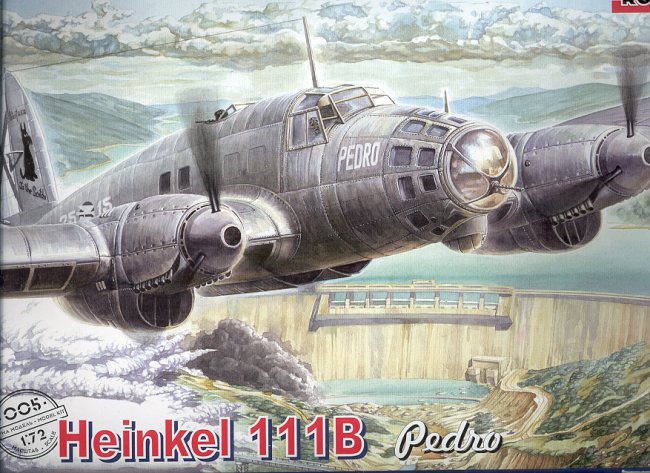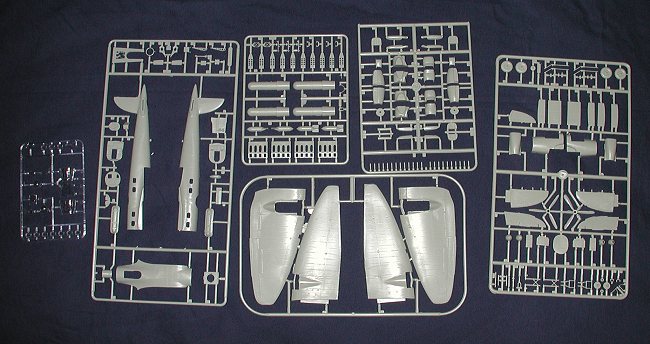
| KIT: | Roden 1/72 He-111B |
| KIT # | 005 |
| PRICE: | @30.00 |
| DECALS: | Three aircraft; see review |
| REVIEW & | |
| NOTES: |

| HISTORY |
The He-111 got an unenviable reputation as a 'weapon of massdestruction' circa 1937, resulting from its use in Spain during the SpanishCivil War. It really was a pretty awesome weapon during its day. No otherproduction bomber could match it. Its major downfall was its lack of range, asthe Luftwaffe really did not build any truly strategic bombers during the war;all were merely used as extensions of ground forces.
The He-111B was the first of the series to be put intoproduction. What made the aircraft a success was its Daimler Benz DB 600engines. Prior to the development of this engine, the Germans had no really goodliquid cooled engines, relying on engines of that type from other countries whena lot of power was required. Not good for propaganda, you know.
The preproduction He-111B-0 aircraft were reaching test units atRechlin in late 1936, with the first production He-111B-1 planes reaching KG 154(later KG 27) just a few months later. Really a remarkably short period of timefor such a new aircraft. Anxious to test their new bomber, two staffeln of111B-1 bombers were sent to Spain in February 1937. These 20 aircraft joinedKG.88 and were used in action for the first time on March 9 of that year. Otherswere supplied to Spanish Nationalist forces.
The next subvariant, the He-111B-2 began rolling off theproduction lines in May of that year. The major difference being in the enginesused, the B-2 having more powerful DB.600s. Overheating was a problem with theB-2 so additional radiators were attached under the leading edges of the wings.Such was the pace of development that the He-111B was quickly supplanted by morecapable variants and relegated to training and transport duties.
| THE KIT |

This is the first Roden kit I have ever seen. Frankly, I am both impressed andcautious. There are lots of parts and individually they are well detailed withengraved panel lines that seem to be so necessary to today's model. On the otherhand, several of the parts have quite a bit of flash on them and the larger bitshave some imperfections and sink marks. This is particularly evident on thefuselage sides. This is due to the thick detail parts on the inside of thefuselage. Where you have thick plastic, you will probably have sink marks.
Theclear bits are nicely detailed and a bit thick. Attachment points are all on thesee-through bits and will need to be polished prior to use. In addition to somesink marks, there are a number of ejector pin marks on the inside of thefuselage and a few other places. These will be difficult to remove withoutdamaging the detail work around them. Speaking of detail work, for a 1/72 kit,the molded in detail on the interior is quite good. In fact, there is a lot ofdetail on the interior. The bomb racks themselves are a major subassembly andfill much of the interior. Too bad that we can't see much of it as there are nobombs for this variant, nor are the bomb doors able to be positioned open unlessyou do some surgery.
The exhaust on this kit is made up of 12separate exhaust pipes for each engine. Definitely not a job for the shaky!However, there is hope. There are some extra exhaust of the collector varietythat are on the sprues, but marked as not to be used. Thanks to the reference, Ihave a photo of a B model using these exhausts which you can see below. You maywish to note that this is one of the planes on the decal sheet. However, thisone has black codes vice the white ones on the sheet. You will also notice thatit looks as if there has been some repainting done of the codes. Since Green'sbook is pretty old and his information could be in error, it is up to themodeler to decide if this easy way out should be used. This aircraft also has adustbin type of lower 'turret'. The instructions only show how to build the kitwith it in the down position.

Overall, it looks like a good kit. It will probably be quite fiddly and have theusual fit problems, but nothing that an experienced modeler shouldn't be able toovercome. Because of all the parts, I would not recommend this to the beginner,but only those with some experience in complicated kits. REFERENCES Bombers and Reconnaissance Aircraft, Vol 9, by WilliamGreen, 1967, Doubleday Review kit courtesy of me and my wallet! If you would like your product reviewed fairly and fairly quickly by asite that has over 1,500 visits a day, please contactme or see other details in the